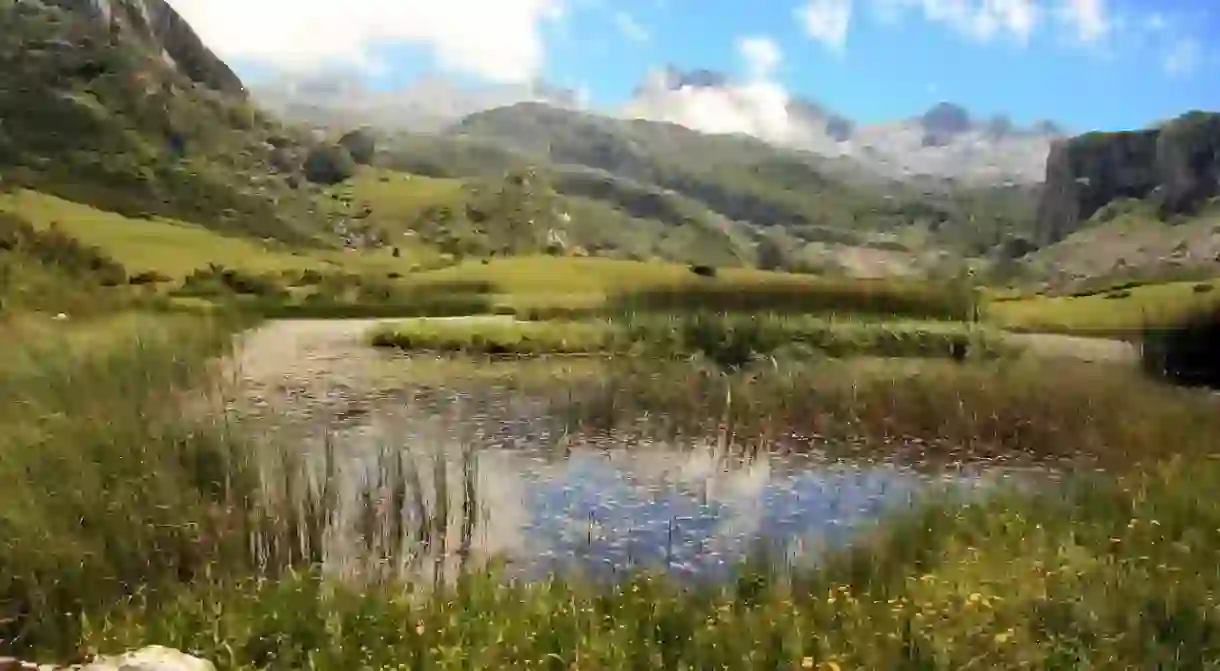15 Reasons to Visit Green Spain at Least Once in Your Lifetime

Green Spain is the name of the area that refers to the stretch of coastline from the French border all the way along the Bay of Biscay and out to the Atlantic. It runs through the autonomous regions of Galicia, Asturias, Cantabria and the Basque Country. Here are 15 reasons to visit this naturally beautiful area of Spain.
It has no less than seven UNESCO World Heritage Sites
Green Spain is home to an impressive seven UNESCO World Heritage, spread across the area. These include the Vizcaya Bridge, Palaeolithic cave art, the monuments in Oviedo and the Kingdom of Asturias, the routes of the Camino de Santiago, the Tower of Hercules, the Old Town of Santiago de Compostela and the Roman Walls of Lugo.
The food is out of this world
This area of Spain is particularly known for its gastronomy, which has now become world famous. The Basque Country in particular has an excellent range of both Michelin-starred fine dining restaurants and rustic bars. One of the top things to try here are pintxos – small pieces of bread topped with various ingredients and taken straight from the top of the bar with your drink. The seafood in Green Spain is also some of the best in the country – think cod, goose barnacles and octopus.

It has stunning pre-Romanesque architecture
The autonomous region of Asturias is home to some of the best pre-Romanesque architecture in Spain, which have also been designated UNESCO World Heritage Sites. Head to the churches of Santa María del Naranco, Santa Cristina de Lena and San Miguel de Lillo for some of the best examples
It’s home to one of the best contemporary art museums in Spain
The Guggenheim Bilbao is not only one of the best contemporary art museums in Spain, but also in the whole world. Designed by the American-Canadian architect Frank Gehry, it looks like a huge floating ship, made from undulating titanium. Some of the artists whose works you can see here include Anish Kapoor, Richard Serra and Jeff Koons.

There’s ancient cave art
The Cantabrian coastal area is in fact home to 18 prehistoric caves, where you can find ancient Palaeolithic cave art. Two of the best are Altamira or El Castillo Cave, where you can find cave drawings that date back over 35,000 years old.
You can walk the Camino del Norte
The Camino del Norte is one of the famous Santiago de Compostela pilgrimage routes across northern Spain. The most popular is the Camino Francés, which passes through cities such as Pamplona, Burgos and León, but the Camino del Norte runs along the coastline passing through some of Northern Spain’s most charming villages and dramatic landscapes.

The Camino de Santiago ends here
The end of the all the Caminos are of course the historic city of Santiago de Compostela and its Cathedral. A charming place, the city is filled with magnificent pieces of architecture, museums, cute narrow streets, and of course a plethora of tapas bars for eating and drinking.
It’s home to one of the oldest lighthouses in the world
The Torre de Hercules, in the coastal Galician city of A Coruña, is one of the oldest lighthouses on the planet, which is still in use today. Dating back to Roman times, visitors can climb its 242 steps to reach the top and look out at the spectacular views over the city and the Atlantic Ocean.

History is everywhere
In the Galician city of Lugo, you can be surrounded by 17 centuries of history in the form of its great city wall. Built in the 3rd century, they are the most complete Roman walls in Europe, and have been declared a UNESCO World Heritage Site.
There’s some great Gaudí designs
El Capricho is one of the few buildings that Gaudí designed, which can be found outside of Barcelona. Located in the village of Comillas, it was built between 1883 and 1885. Taking inspiration from Japanese, Indian and Moorish Islamic art, the building is covered in Gaudí’s hallmark colourful tiles and quirky chimneys.

You can cross the world’s oldest transporter bridge
Bilbao’s Vizcaya Bridge is the oldest transporter bridge in the world. It was designed by the architect Alberto de Palacio and was first opened in 1893. Measuring 45 metres (148 feet) high and 160 metres (525 feet) long, six million people use it to cross the river estuary every year.
The cider is Spain’s best
The Basque Country and the region of Asturias make Spain’s best cider, known as sidra, and are filled with cider houses and taverns. Unlike the cider you may be used to, Spanish cider is cloudy instead of clear, is slightly tart and not sparkling.

Architect Oscar Niemeyer created his first work here
In the town of Avilés, visitors can see the the first work by the architect Oscar Niemeyer. A cultural centre, it consists of a large circular tower and a geometric dome in bright colours of white, red and yellow. Featuring a wide cultural programme of events, it also has a viewing platform and restaurant, which offers beautiful city views.
It’s a cheese lover’s paradise
Not only is Green Spain great for pintxos, seafood and cider, it is also an excellent place for cheese. Asturias is particularly good, as is the Basque Country. There is even a dedicated cheese hiking trail, which takes visitors from the pastures to the dairy farms and the cheese markets – the Idiazábal Cheese Trail.

It has spectacular landscapes
Green Spain is a different side to Spain, full of lush green meadows, soaring mountains and dramatic coastal landscapes. You’ll need your camera ready at all times when touring this part of the country.
For more Green Spain travel inspiration, read our article on the top reasons to visit Asturias.













